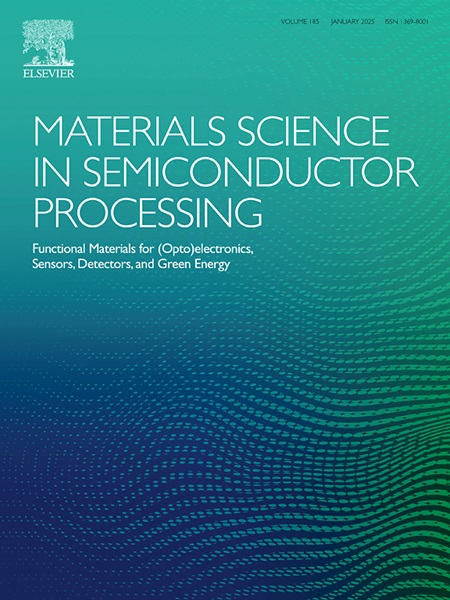Mimicking synaptic plasticity based on TiO2/MgO film resistive switching device
IF 4.2
3区 工程技术
Q2 ENGINEERING, ELECTRICAL & ELECTRONIC
引用次数: 0
Abstract
The TiO2/MgO composite film was prepared via atomic layer deposition, exhibiting superior resistive switching (RS) performance compared to pure MgO film, including a higher resistance ratio (Roff/Ron) and enhanced retention. The Ag/TiO2/MgO/ITO device exhibited gradual RS characteristics, making it suitable for neuromorphic applications. The device also displayed excellent multilevel RS properties analogous to synaptic plasticity. When a series of positive or negative scanning voltages with progressively increasing amplitudes were applied, the resistance of the device switched and remained at correspondingly higher or lower states, effectively mimicking synaptic potentiation or depression in an amplitude-dependent manner. Furthermore, long-term potentiation and depression behaviors were observed under the time-dependent stimulation. As the pulse voltage amplitude increased, fewer pulses were required to set the device to a specific state. Conversely, lower voltage necessitated more pulses to facilitate Ag ions migration and conductive filament formation. This dynamic mimics synaptic weight modulation, where the evaluation of filaments over time corresponds to synaptic adjustment. Therefore, applying higher or lower amplitude voltages for longer or shorter durations aligns with the observation, where varying stimuli to the presynaptic membrane modulate synaptic weight, thereby strengthening (and weakening) the synaptic signal. The pulse amplitude and duration thresholds modulate the RS behavior of the composite TiO2/MgO film effectively mimic the learning and forgetting processes of human brain memory.
基于TiO2/MgO薄膜电阻开关器件的突触可塑性模拟
通过原子层沉积法制备了TiO2/MgO复合膜,与纯MgO膜相比,具有更高的电阻比(Roff/Ron)和增强的保留性能。Ag/TiO2/MgO/ITO器件具有逐渐RS特性,适合神经形态应用。该装置还显示出类似于突触可塑性的优异的多能级RS特性。当施加一系列振幅逐渐增加的正或负扫描电压时,器件的电阻切换并保持在相应的较高或较低的状态,以振幅依赖的方式有效地模拟突触增强或抑制。在时间依赖性刺激下观察到长时程增强和抑郁行为。随着脉冲电压幅值的增加,需要更少的脉冲来将器件设置到特定状态。相反,较低的电压需要更多的脉冲来促进银离子的迁移和导电丝的形成。这种动态模拟突触重量调节,其中纤维随时间的评估对应于突触调节。因此,在更长或更短的时间内施加更高或更低的振幅电压与观察结果一致,其中对突触前膜的不同刺激调节突触重量,从而增强(或减弱)突触信号。脉冲振幅和持续时间阈值调节TiO2/MgO复合膜的RS行为,有效地模拟了人脑记忆的学习和遗忘过程。
本文章由计算机程序翻译,如有差异,请以英文原文为准。
求助全文
约1分钟内获得全文
求助全文
来源期刊

Materials Science in Semiconductor Processing
工程技术-材料科学:综合
CiteScore
8.00
自引率
4.90%
发文量
780
审稿时长
42 days
期刊介绍:
Materials Science in Semiconductor Processing provides a unique forum for the discussion of novel processing, applications and theoretical studies of functional materials and devices for (opto)electronics, sensors, detectors, biotechnology and green energy.
Each issue will aim to provide a snapshot of current insights, new achievements, breakthroughs and future trends in such diverse fields as microelectronics, energy conversion and storage, communications, biotechnology, (photo)catalysis, nano- and thin-film technology, hybrid and composite materials, chemical processing, vapor-phase deposition, device fabrication, and modelling, which are the backbone of advanced semiconductor processing and applications.
Coverage will include: advanced lithography for submicron devices; etching and related topics; ion implantation; damage evolution and related issues; plasma and thermal CVD; rapid thermal processing; advanced metallization and interconnect schemes; thin dielectric layers, oxidation; sol-gel processing; chemical bath and (electro)chemical deposition; compound semiconductor processing; new non-oxide materials and their applications; (macro)molecular and hybrid materials; molecular dynamics, ab-initio methods, Monte Carlo, etc.; new materials and processes for discrete and integrated circuits; magnetic materials and spintronics; heterostructures and quantum devices; engineering of the electrical and optical properties of semiconductors; crystal growth mechanisms; reliability, defect density, intrinsic impurities and defects.
 求助内容:
求助内容: 应助结果提醒方式:
应助结果提醒方式:


